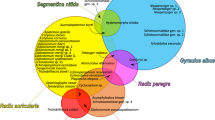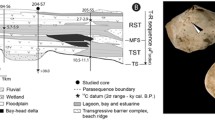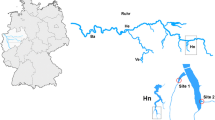Abstract
Trematodes are abundant parasites essential for maintaining stability of marine intertidal ecosystems. Despite the great ecological significance of trematodes, long-term dynamics of their communities remains practically unstudied. This study, based on 12-year-long seasonal monitoring of infection of Littorina and Hydrobia snails with 16 trematode species in the White Sea, aimed to reveal factors determining long-term variation in infection of intertidal snails by trematode parthenitae and larvae. Using the state-of-the-art method of singular spectrum analysis, we revealed trends in this variation and assessed their significance. Interestingly, these trends were not associated with oceanic and climatic parameters but were mostly determined by changes in abundance of the trematode final hosts. Moreover, the prevalence trends turned out to be connected with both large-scale events and local factors at the scale of the intertidal site. The main factors determining the long-term dynamics of the trematode component communities in the study area were the decreasing abundance of birds due to growing anthropogenic disturbance and the increasing abundance of the three-spined stickleback. The analysis of long-term trends of trematode prevalence in intertidal snails may be a sensitive indicator of the abundance dynamics of final hosts in the coastal areas of temperate and northern seas.



Similar content being viewed by others
References
Berger, V., A. Naumov, M. Zubaha, N. Usov, I. Smolyar, R. Tatusko & S. Levitus, 2003. 36-Year time series (1963–1998) of zooplankton, temperature and salinity in the White Sea. S-Peterburg–Washington: 362 pp.
Berger, V. J., Naumov, A. D. & A. A. Sukhotin, 2012. Conclusion. Concentration of pollutants in the White Sea organisms. In Berger, V. J. (ed.), Biological Resources of the White Sea and their Rational Exploitation. Explorations of Fauna of the Seas, 69 (77). Zoological Institute of the Russian Academy of Sciences Publishing, St. Petersburg: 320–325 (in Russian).
Bustnes, J. O., K. V. Galaktionov & S. W. B. Irwin, 2000. Potential threats to littoral biodiversity: is increased parasitism a consequence of human activity? Oikos 90: 189–190.
Byers, J. E., A. M. H. Blakeslee, E. Linder, A. B. Cooper & T. J. Maguire, 2008. Controls of spatial variation in the prevalence of trematode parasites infecting a marine snail. Ecology 89: 439–451.
Combes, C., 2001. Parasitism, the Ecology and Evolution of Intimate Interactions. The University of Chicago Press, Chicago.
Deblock, S., 1980. Inventaire des trématodes larvaires parasites des mollusques Hydrobia (Prosobranches) des côtes de France. Parassitologia 22: 1–105.
Doi, H. & N. I. Yurlova, 2011. Host–parasite interactions and global climate oscillations. Parasitology 138: 1022–1028.
Elsner, J. & A. Tsonis, 1996. Singular Spectrum Analysis. A New Tool in Time Series Analysis. Plenum Press, New York.
Ewers, W. H., 1964. The influence of the density of snails on the incidence of larval trematodes. Parasitology 54: 579–583.
Fermer, J., S. C. Culloty, T. C. Kelly & R. M. O’Riordan, 2010. Temporal variation of Meiogymnophallus minutus infections in the first and second intermediate host. Journal of Helminthology 84: 362–368.
Fredensborg, B. L., K. N. Mouritsen & R. Poulin, 2006. Relating bird host distribution and spatial heterogeneity in trematodes infection in an intertidal snail-from small to large scale. Marine Biology 149: 275–283.
Galaktionov, K. V., 1983. Microphallids of the “pygmaeus” group. I. Description of species Microphallus pygmaeus (Levinsen, 1881) nec Odhner, 1905 and M. piriformes (Odhner, 1905) nom. nov. (Trematoda: Microphallidae). Vestnik Leningradskogo Universiteta 15(3): 20–30. (in Russian).
Galaktionov, K. V., 1984. Microphallids of the “pygmaeus” group. II. Microphallus triangulatus sp. nov. (Trematoda: Microphallidae). Vestnik Leningradskogo Universiteta 3: 5–11. (in Russian).
Galaktionov, K. V., 1988. Cercariae and metacercariae of Levinseniella brachysoma (Trematoda, Microphallidae) from invertebrates of the White Sea. Parazitologiya 22: 304–311. (in Russian).
Galaktionov, K. V., 1992. Seasonal dynamics of age composition in component populations of daughter sporocyst of microphallids of the “pygmaeus” group (Trematoda, Microphallidae) in the intertidal molluscs Littorina saxatilis in the Barents Sea. Parazitologiya 26: 462–469. (in Russian).
Galaktionov, K. V., 2009. Description of the maritae and determination of the species status of Microphallus pseudopygmaeus sp. nov. (Trematoda: Microphallidae). Parazitologiya 43: 289–299. (in Russian).
Galaktionov, K. V. & A. A. Dobrovolskij, 2003. The Biology and Evolution of Trematodes. Kluwer Academic Publishers, Boston.
Galaktionov, K. V., Irwin, S. W. B., Prokofiev, V. V., Saville, D. H., Nikolaev, K. E. & I. A. Levakin, 2006. Trematode transmission in coastal communities—temperature dependence and climate change perspectives. 11th International Congress of Parasitology (ICOPA XI). Medimond International Proceedings: 85–90.
Golub, G. H. & C. F. van Loan, 1996. Matrix Computations, 3rd edn. The Johns Hopkins University Press, Baltimore.
Golyandina, N., V. Nekrutkin & A. Zhigljavsky, 2001. Analysis of Time Series Structure: SSA and Related Techniques. Chapman & Hall/CRC, Boca Raton.
Gorbushin, A. M., 1993. Structure of the lines of winter growth interruption and their formation in the shells of Hydrobia ulvae (Gastropoda: Prosobranchia) in the White Sea. Zoologicheskiy Zhurnal 72: 29–34. (in Russian).
Granovitch, A. I., S. O. Sergievsky & I. M. Sokolova, 2000. Spatial and temporal variation of trematode infestation in coexisting populations of intertidal gastropods Littorina saxatilis and L. obtusata in the White Sea. Diseases of Aquatic Organisms 41: 53–64.
Hechinger, R. F. & K. D. Lafferty, 2005. Host diversity begets parasite diversity: bird final hosts and trematodes in snail intermediate hosts. Proceedings of the Royal Society B 272: 1059–1066.
Hudson, P. J., A. P. Dobson & D. Newborn, 2003. Parasitic worms and the population cycles of Red grouse (Lagopus lagopus scoticus). In Berryman, A. (ed.), Population Cycles. Oxford University Press, New York: 109–129.
Hughes, R. N. & P. Answer, 1982. Growth, spawning and trematode infection of Littorina littorea (L.) from an exposed shore in North Wales. Journal of Molluscan Studies 48: 321–330.
Huspeni, T. C. & K. D. Lafferty, 2004. Using larval trematodes that parasitize snails to evaluate a saltmarsh restoration project. Journal of Applied Ecology 14: 795–804.
Ivanova, T. S., Lajus, D. L., Shatskikh, E. V. & M. V. Ivanov, 2010. Number dynamics of three-spined stickleback in the White Sea: the current state. In Naumov, A. D., A. P. Alekseev & A. A. Sukhotin (eds), Problems of study, rational exploitation and conservation of natural resources of the White Sea. Proceedings of the XI international conference, St. Petersburg, 9–11 November 2010. Zoological Institute of the Russian Academy of Sciences Publishing, St. Petersburg: 59–60 (in Russian).
James, B. L., 1968. The distribution and keys of species in the family Littorinidae and their digenean parasites, in the region of Dale, Pembrokeshire. Field Studies 2: 615–650.
Jolliffe, I. T., 2002. Principal Component Analysis. Series: Springer Series in Statistics, 2nd edn, Vol. XXIX. Springer, New York.
Kennedy, C. R., P. C. Shears & J. A. Shears, 2001. Long-term dynamics of Ligula intestinalis and roach Rutilus rutilus: a study of three epizootic cycles over thirty-one years. Parasitology 123: 257–269.
Kozminsky, E. V., 2006. Determination of age in Littorina obtusata (Gastropoda, Prosobranchia). Zoologicheskiy Zhurnal 85: 146–157. (in Russian).
Krasnov, Yu. V., 2012. Seabirds of the White Sea: current state of the populations, distribution and trophic connections. In Berger, V. J. (ed.), Biological Resources of the White Sea and their Rational Exploitation. Explorations of Fauna of the Seas, 69(77). Zoological Institute of the Russian Academy of Sciences Publishing, St. Petersburg: 244–260 (in Russian).
Kube, S., J. Kube & A. Bick, 2002a. Component community of larval trematodes in the mudsnail Hydrobia ventrosa: temporal variation in prevalence in relation to host life history. Journal of Parasitology 88: 730–737.
Kube, J., S. Kube & V. Dierschke, 2002b. Spatial and temporal variations in the trematode component community of the mudsnail Hydrobia ventrosa in relation to the occurrence of waterfowl as definitive hosts. Journal of Parasitology 88: 1075–1086.
Lajus, D. L., E. V. Shatskikh, T. S. Ivanova & M. V. Ivanov, 2011. “Waves of life” of three-spined stickleback in the White Sea. In Maximovich, N. V. & I. A. Stogov (eds), Proceedings of XIII scientific workshop “Readings in memory of K. M. Derjugin”. St. Petersburg State University Press, St. Petersburg: 64–98 (in Russian).
Loot, G., M. Aldana & S. A. Navarrete, 2005. Effects of human exclusion on parasitism in intertidal food webs of Central Chile. Conservation Biology 19: 203–212.
Marcogliese, D. J., 2005. Parasites of the superorganism: are they indicators of ecosystem health? International Journal for Parasitology 35: 705–716.
Marcogliese, D. J., T. M. Goater & G. W. Esch, 1990. Crepidostomum cooperi (Allocreadidae) in the burrowing mayfly, Hexagenia limbata (Ephemeroptera) related to trophic status of a lake. American Midland Naturalist 124: 309–317.
Matthews, P. M., W. I. Montgomery & R. E. B. Hanna, 1985. Infestation of littorinids by larval digenea around a small fishing port. Parasitology 90: 277–287.
Matveeva, T. A., 1974. The ecology and life cycles of abundant species of the gastropod molluscs of Barents and White Seas. In Khlebovich, V. (ed.), Seasonal Phenomena in the Life of the White and Barents Seas (Explorations of the Fauna of the Seas XIII). Nauka, Leningrad: 65–190.
Merlo, M. J. & J. A. Etchegoin, 2011. Testing temporal stability of the larval digenean community in Heleobia conexa (Mollusca: Cochliopidae) and its possible use as an indicator of environmental fluctuations. Parasitology 138: 249–256.
Mouritsen, K. N., 2002. The Hydrobia ulvae–Maritrema subdolum association: influence of temperature, salinity, light, water-pressure and secondary host exudates on cercarial emergence and longevity. Journal of Helminthology 76: 341–347.
Mouritsen, K. N. & R. Poulin, 2002. Parasitism, community structure and biodiversity in intertidal ecosystems. Parasitology 124: S101–S117.
Mouritsen, K. N. & R. Poulin, 2010. Parasitism as a determinant of community structure on intertidal flats. Marine Biology 157: 201–213.
Naumov, A. D., V. J. Berger & K. V. Galaktionov, 2003. Features of White Sea ecosystems: the structure and dynamics of benthic and pelagic communities. Oceanology 43(Suppl 1): S134–S143.
Persson, J., L. C. Stige, N. C. Stenseth, N. Usov, & D. Martynova, 2012. Scale-dependent effects of climate on two copepod species, Calanus glacialis and Pseudocalanus minutus, in an Arctic-boreal sea. Marine Ecology Progress Series (in press).
Poulin, R., 2007. Evolutionary Ecology of Parasites. Princeton University Press, Princeton, NJ.
Poulin, R. & K. N. Mouritsen, 2003. Large-scale determinants of trematode infections in intertidal gastropods. Marine Ecology Progress Series 254: 187–198.
Poulin, R. & K. N. Mouritsen, 2006. Climate change, parasitism and the structure of intertidal ecosystems. Journal of Helminthology 80: 183–191.
Prokofiev, V. V., 1999. Influence of temperature and salinity on a life span of cercariae of littoral trematodes Cryptocotyle sp. (Heterophyidae), Levinseniella brachysoma and Maritrema subdolum (Microphallidae). Parazitologiya 33: 520–525. (in Russian).
Prokofiev, V. V., 2001. Influence of temperature and salinity on a life span of cercariae of littoral trematodes Podocotyle atomon (Opecoealidae) and Renicola thaidus (Renicolidae). Parazitologiya 35: 69–76. (in Russian).
Reimer, L. W., 1971. Neue Cercarien der Ostsee mit einer Diskussion ihrer möglichen Zuordnung und einem Bestimmungsschlüssel. Parasitologische Schriftenreihe 21: 125–149.
Robson, E. M. & I. C. Williams, 1970. Relationships of some species of Digenea with the marine prosobranch Littorina littorea (L.) I. The occurrence of larval Digenea in L. littorea on the North Yorkshire coast. Journal of Helminthology 44: 153–168.
Shulman, S. S. & R. E. Shulman-Al’bova, 1953. Parasites of the Fishes of the White Sea. USSR Academy of Sciences Publishing, Moscow. (in Russian).
Skírnisson, K., K. V. Galaktionov & E. V. Kozminsky, 2004. Factors influencing the distribution of digenetic trematode infections in a mudsnail (Hydrobia ventrosa) population inhabiting salt marsh ponds in Iceland. Journal of Parasitology 90: 50–59.
Smith, N. F., 2001. Spatial heterogeneity in recruitment of larval trematodes to snail intermediate hosts. Oecologia 127: 115–122.
Sokal, R. R. & F. J. Rohlf, 1995. Biometry, 3rd edn, 3rd ed. W. H. Freeman, New York.
Stunkard, H. W., 1967. Studies on the Trematode Genus Paramonostomum Lühe, 1909 (Digenea: Notocotylidae). Biological Bulletin 132: 133–145.
Thieltges, D. W., 2006. Parasite induced summer mortality in the cockle Cerastoderma edule by the trematode Gymnophallus choledochus. Hydrobiologia 559: 455–461.
Thomas, F., J.-F. Guégan & F. Renaud (eds.), 2009. Ecology and Evolution of Parasitism. Oxford University Press, New York.
Torchin, M. E., K. D. Lafferty & A. M. Kuris, 2002. Parasites and marine invasions. Parasitology 124: S137–S151.
Usov, N., Martynova, D., Primakov, I. & I. Kutcheva, 2009. Long-term zooplankton dynamics and environment in the White Sea since 1957. From ecosystem function to prediction. In 3rd GLOBEC Open Science Meeting. Victoria, BC, Canada: 126–127.
Valtonen, E. T., E. Helle & R. Poulin, 2004. Stability of Corynosoma populations with fluctuating population densities of the seal definitive host. Parasitology 129: 635–642.
Voutilainen, A., T. van Ooik, M. Puurtinen, R. Kortet & J. Taskinen, 2009. Relationship between prevalence of trematode parasite Diplostomum sp. and population density of its snail host Lymnaea stagnalis in lakes and ponds in Finland. Aquatic Ecology 43: 351–357.
Wilson, R. A. & S. L. Taylor, 1978. The effect of variations in host and parasite density on the level of parasitization of Lymnaea truncatula by Fasciola hepatica. Parasitology 76: 91–98.
Yurlova, N. I., S. N. Vodyanitskaya, E. A. Serbina, V. Y. Biserkov, B. B. Georgiev & N. H. Chipev, 2006. Temporal variation in prevalence and abundance of metacercariae in the pulmonate snail Lymnaea stagnalis in Chany Lake, West Siberia, Russia: long-term patterns and environmental covariates. Journal of Parasitology 92: 249–259.
Acknowledgments
We are grateful to the foundations that have supported this research over the years: INTAS (the International Association for the Promotion of Co-operation with Scientists from the New Independent States of the Former Soviet Union), RFBR (the Russian Foundation for Basic Research) and St. Petersburg State University (Grant Number 1.37.80.2011). We thank Natalia Lentsman for her help with English translation of the MS. We thank the anonymous reviewers for their well-considered comments on an earlier draft of the manuscript.
Author information
Authors and Affiliations
Corresponding author
Additional information
Guest editor: A. A. Sukhotin / Long-term research on marine ecosystems in the White Sea, Russia
Electronic supplementary material
Below is the link to the electronic supplementary material.
Rights and permissions
About this article
Cite this article
Levakin, I.A., Nikolaev, K.E. & Galaktionov, K.V. Long-term variation in trematode (Trematoda, Digenea) component communities associated with intertidal gastropods is linked to abundance of final hosts. Hydrobiologia 706, 103–118 (2013). https://doi.org/10.1007/s10750-012-1267-x
Received:
Accepted:
Published:
Issue Date:
DOI: https://doi.org/10.1007/s10750-012-1267-x




